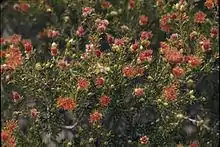| Rusty eremaea | |
|---|---|
 | |
| Scientific classification | |
| Kingdom: | Plantae |
| Clade: | Tracheophytes |
| Clade: | Angiosperms |
| Clade: | Eudicots |
| Clade: | Rosids |
| Order: | Myrtales |
| Family: | Myrtaceae |
| Genus: | Eremaea |
| Species: | E. acutifolia |
| Binomial name | |
| Eremaea acutifolia | |
| Synonyms[1] | |
|
Melaleuca acrifolia Craven & R.D.Edwards | |

Eremaea acutifolia, commonly known as rusty eremaea,[2] is a plant in the myrtle family, Myrtaceae and is endemic to the south-west of Western Australia. It is a small shrub with needle-like leaves and which bears orange-coloured flowers on short side branches and fruits with a surface that is rough to the touch.
Description
Eremaea acutifolia is an erect to spreading shrub which sometimes grows to a height of 0.7 metres (2 ft) and which, unlike some others in the genus, lacks a lignotuber. The leaves are linear to narrow elliptic in shape, 3.6–9.5 millimetres (0.1–0.4 in) long, 0.5–1.2 millimetres (0.02–0.05 in) wide and have a single prominent vein visible on the lower surface.[3]
The flowers are usually orange, rarely dark pink and are on the ends of short side branches off the previous year's wood. The flowers occur singly, rarely two together. There are 5 sepals which are hairy on the outside surface and 5 petals 3–4 millimetres (0.1–0.2 in) long. The stamens are arranged in 5 bundles, each containing 28 to 34 stamens. Flowering occurs from August to November and is followed by fruits which are woody capsules. The capsules are 3.5–6 millimetres (0.1–0.2 in) long, shaped like an inverted cone and are rough or lumpy on the outer surface.[3]
Taxonomy and naming
Eremaea acutifolia was first formally described in 1860 by Ferdinand von Mueller in Fragmenta Phytographiae Australiae.[4][5] The specific epithet (acutifolia) is from the Latin acutus meaning "sharp" or "pointed"[6]: 69 and folium meaning "a leaf"[6]: 466 referring to the pointed leaves of this species.[3]
Distribution and habitat
Eremaea acutifolia is only found in a small area east of Geraldton[3] in the Avon Wheatbelt and Geraldton Sandplains biogeographic regions.[2] It grows in sand on sandplains.[7]
Conservation
Eremaea acutifolia is classified as "Priority Three" by the Western Australian Government Department of Parks and Wildlife[2] meaning that it is poorly known and known from only a few locations but is not under imminent threat.[8]
References
- 1 2 "Eremaea acutifolia". Australian Plant Census. Retrieved 3 April 2021.
- 1 2 3 "Eremaea acutifolia". FloraBase. Retrieved 8 August 2015.
- 1 2 3 4 Hnatiuk, Roger J. (1998). "A revision of the genus Eremaea (Myrtaceae)". Nuytsia. 9 (2): 202–205. Retrieved 2 November 2020.
- ↑ von Mueller, Ferdinand (1860). Fragmenta Phytographiae Australiae (Volume 2). Melbourne. p. 30. Retrieved 8 August 2015.
{{cite book}}: CS1 maint: location missing publisher (link) - ↑ "Eremaea acutifolia". APNI. Retrieved 8 August 2015.
- 1 2 Brown, Roland Wilbur (1956). The Composition of Scientific Words. Washington, D.C.: Smithsonian Institution Press.
- ↑ Paczkowska, Grazyna; Chapman, Alex R. (2000). The Western Australian flora : a descriptive catalogue. Perth: Wildflower Society of Western Australia. p. 361. ISBN 0646402439.
- ↑ "Conservation codes for Western Australian Flora and Fauna" (PDF). Government of Western Australia Department of Parks and Wildlife. Retrieved 9 August 2019.
